Frank ICSE Class 10 Physics Solutions Light
Formulae Handbook For ICSE Class 9 and 10 Educational Loans in India
ICSE class 10 Physics study material Light
Frank ICSE Class 10 Physics Solutions Light Refraction And Total Internal Reflection
PAGE NO-102:
Solution 1
Refraction is the bending of light at the surface of separation, which takes when it passes from one optical medium to another optical medium with different optical densities.
Solution 2

Solution 3
Yes, reflection also takes place with the refraction.
Solution 4
When a ray of light passes from one medium to another, its direction (except for normal incidence) changes because of change in speed of light. Thus, refraction occurs because light travels with different speed in different media.
Solution 5
The ray of light which is incident normally on the surface separating the two media passes undeviated. Such ray suffers no bending, thus, angle of refraction and angle of deviation is 0
o
.
Solution 6
The phenomenon is total internal reflection
Solution 7
Refractive index being the ratio of similar quantities has no units.
Solution 8

Solution 9
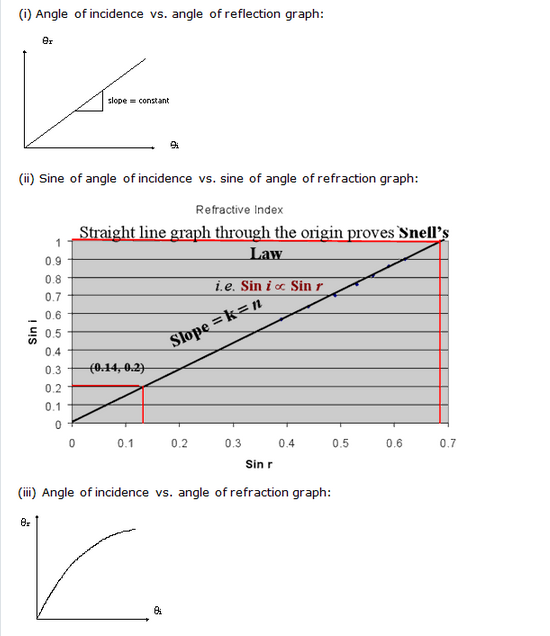
Solution 10

Solution 11
Red colour of white light has least refractive index.
Solution 12
Violet colour of white light has highest refractive index.
Solution 13
According to the principle of reversibility, the path of a light ray is reversible.For e.g. if light travels from air to water along a certain path, then if the path is reversed while travelling from water to air, it will follow exactly the same path.
Solution 14
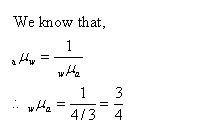
Solution 15
The absolute refractive index of a medium is defined as the ratio of the speed of e-m radiation in free space to the speed of radiation in that medium.
Solution 16
When light travels from one medium (air) to another medium (glass), it bends towards the normal. The extent of bending of light depends upon the speed of light (v
2
) in the second medium, compared to the speed of light (v
1
) in the first medium. The refractive index of the second medium w.r.t. the first medium (n
21
) is given byn
21
= Speed of light (v
1
) in first medium / speed of light (v
2
) in second mediumThe refractive index of glass is typically around 1.5, meaning that light in glass travels at c / 1.5 = 200,000 km/s. A low value of refractive index also indicates a large critical angle at the glass-air interface.
Solution 17
No, dispersion is not same as deviation.
Solution 18
Angle of deviation may be defined as the angle between original path of incident ray and the path of refracted ray.
Solution 19
The value of angle of deviation produced by a prism depends upon:
(i) The angle of incidence
(ii) The material of prism
(iii) The angle of prism
(iv) The colour of wavelength of light used.
Solution 20
(c) Diamond
Solution 21
(a) 0
o
Solution 22
Ray B is the correct refracted ray because a ray of light travelling from air (rarer medium) to water (denser medium) will bend towards the normal.
Solution 23
The correct path is that of ray ‘B’.
PAGE NO-103:
Solution 24
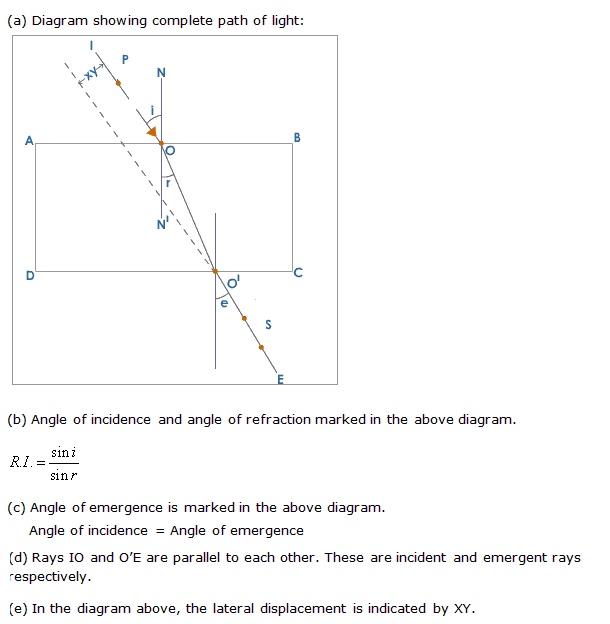
Solution 25
Factors affecting the critical angle are:
(i) The colour (or wavelength) of light.
(ii) The temperature (on changing the temperature of medium, its refractive index changes).
Solution 26
The critical angle for a pair of media is:(i) more than 45
o
for red light.(ii) less than 45
o
for blue light.
Solution 27
(a) towards the normal.
(b) away from the normal.
(c) 2/3.
Solution 28
Critical angle is the angle of incidence in the denser medium for which the angle of refraction in the rarer medium is 90o.Total internal reflection: When a ray of light travelling from an optically denser medium to an optically rare medium is incident at an angle greater than the critical angle for the pair of media in contact, the ray is totally reflected back into the denser medium. This phenomenon is referred as total internal reflection.The two necessary conditions for total internal reflection to take place are:
1. The light ray must proceed from denser to rarer medium.
2. Angle of incidence in denser medium should be greater than the critical angle for the pair of media in contact.Relation between critical angle and r.i.: The critical angle can thus be calculated by taking the inverse-sine ratio of speed of light in denser medium and the speed of light in rarer.
Solution 29
The critical angle for diamond is 24
o
; this indicates that diamond has high refractive index of 2.42. This low value of critical angle facilitates total internal reflection of each light ray entering the diamond at its multiple surfaces.
Solution 30
Refraction is the bending of light at the surface of separation, which takes when it passes from one optical medium to another optical medium with different optical densities.Ray diagram showing refraction of light through a glass slab:
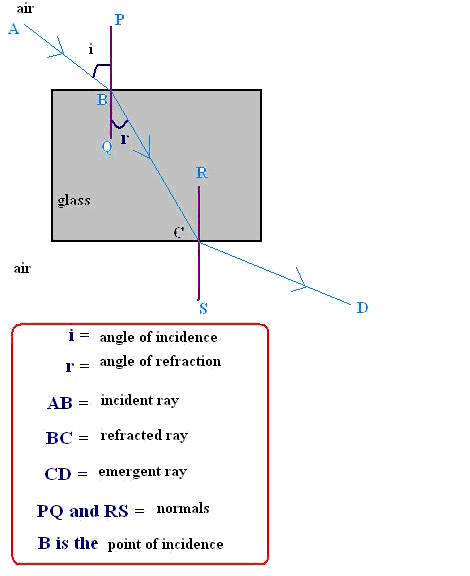
Solution 31
Two advantages of using total reflecting prism as a reflector in place of a plane mirror are:
(i) When total internal reflection occurs, the entire light (100%) is reflected back into the denser medium, whereas in ordinary reflection from plane mirror, some light is refracted or absorbed (i.e. reflection is partial).
(ii) Total reflecting prism gives a much brighter image than that obtained by using the plane mirror.
Solution 32
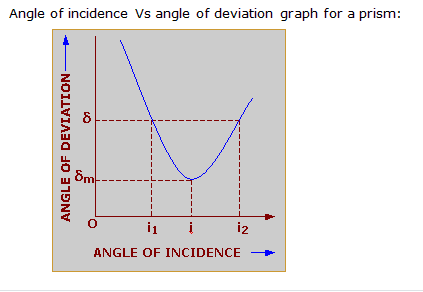
Frank ICSE Class 10 Physics Solutions Light
PAGE NO-115:
Solution 1
A lens may be defined as a transparent refracting medium bounded by two curved surfaces which are generally spherical.
Solution 2

Solution 3
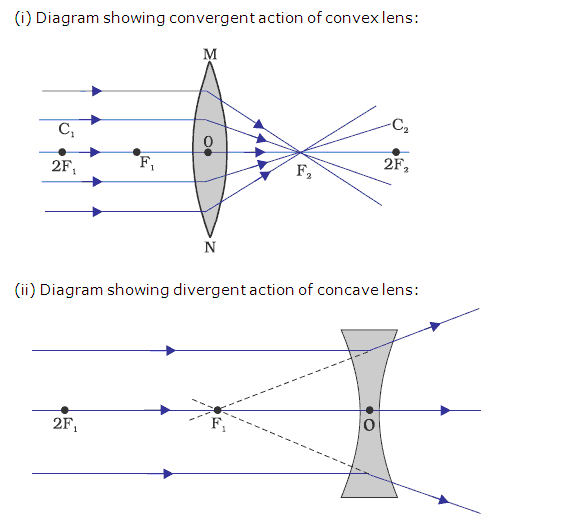
Solution 4
Focal length of a lens: Rays of light can pass through the lens in any direction and hence there will be two focal lengths on either side of the lens and they are referred to as the first focal length and the second focal length of a lens:
(i) First focal length: The distance from the optical centre of the lens to its first focal point is called the first focal length (f
1
) of the lens.
(ii) Second focal length: The distance from the optical centre of the lens to its second focal point is called the second focal length (f
2
) of the lens.
Solution 5
Focal length of a plane mirror is infinity.
Solution 6
The SI unit of focal length is ‘metre’.
Solution 7
Principal axis of a lens is the line joining the centres of curvatures of the two surfaces of the lens.
Solution 8
Focal plane of a lens: Rays of light can pass through the lens in any direction and hence there will be two focal planes on either side of the lens and they are referred to as the first focal plane and the second focal plane of a lens:
(i) First focal plane: It is the plane passing through the first focal point and normal to the principal axis of the lens.
(ii) Second focal plane: It is the plane passing through the second focal point and normal to the principal axis of the lens.
Solution 9
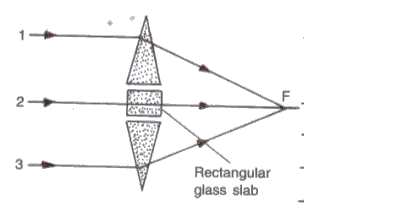
PAGE NO-116:
Solution 10
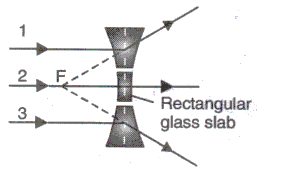
Solution 11
(i) If the medium on both sides of the lens is same, the first and second focal lengths are equal.
(ii) A ray of light passing through the optical centre of the lens passes undeviated.
Solution 12
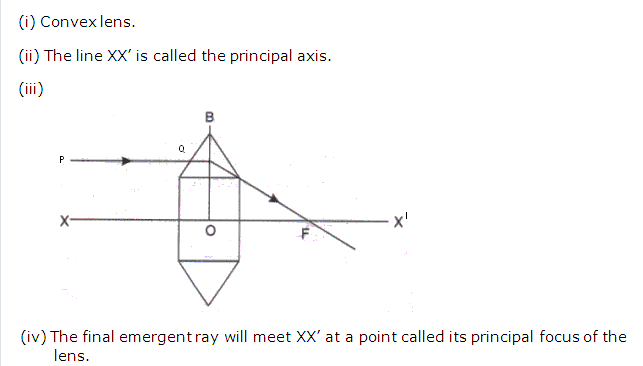
Solution 13
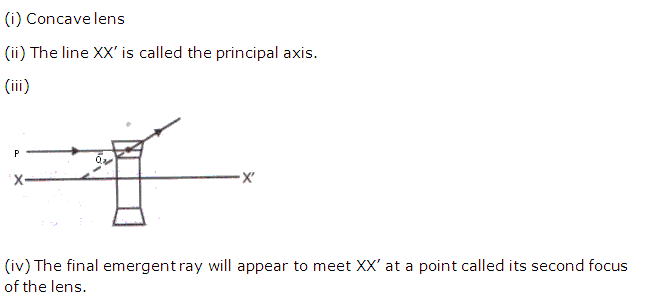
Solution 14
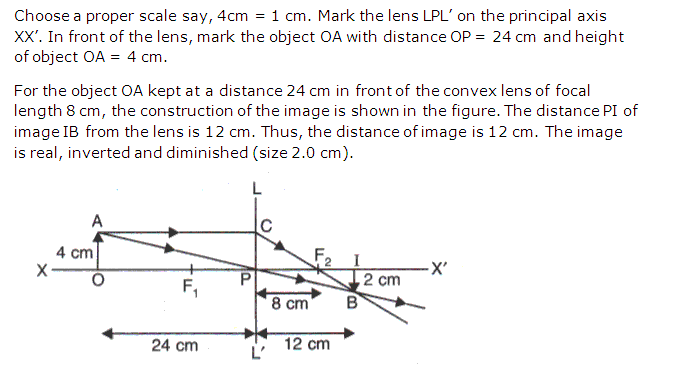
Solution 15
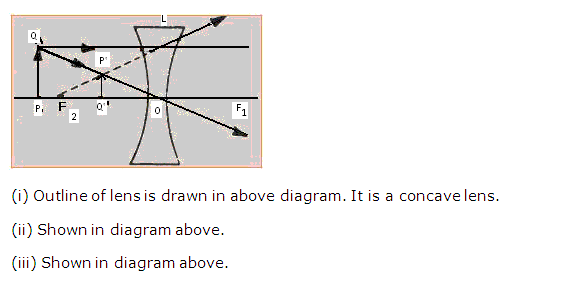
Solution 16
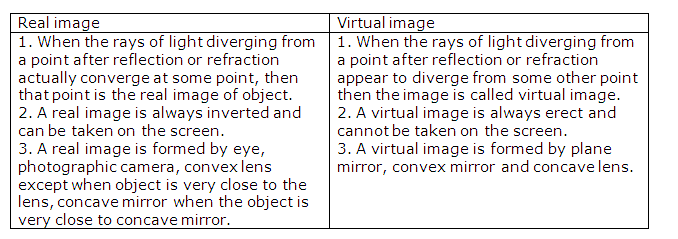
Solution 17
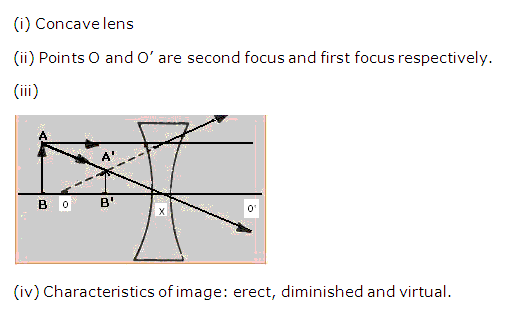
PAGE NO-117:
Solution 18
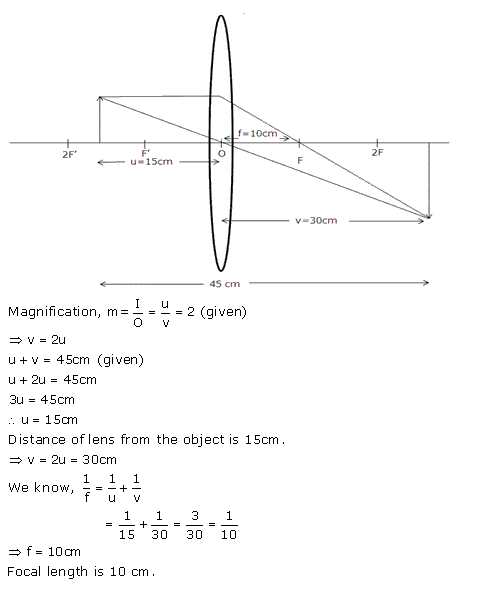
Solution 19
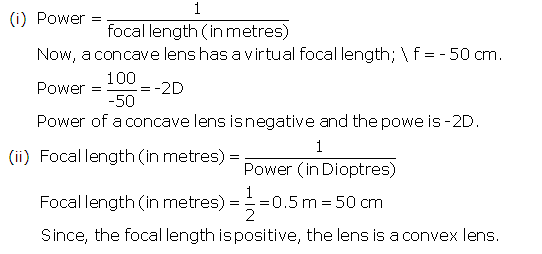
Frank ICSE Class 10 Physics Solutions Light Dispersion through a prism and Electromagnetic Spectrum
PAGE NO-123:
Solution 1
The phenomenon of splitting of white light into its constituent colours is known as dispersion.
Solution 2
(i) Ultra-violet radiation
(ii) Infra-red radiation
Solution 3
3 x 10
8
m/s is the velocity of electromagnetic radiation.
Solution 4
Light of different colours have different speeds in a medium.Therefore, the refractive index of glass (the material of prism) is different for different colours of light and the deviation caused by a prism is different for different colours of light.Violet is deviated the most because in glass, speed of violet is least.Red is deviated the least because in glass, speed of red is most.
Solution 5
The colour band obtained on a screen on passing white light through a prism is called the spectrum.
Solution 6
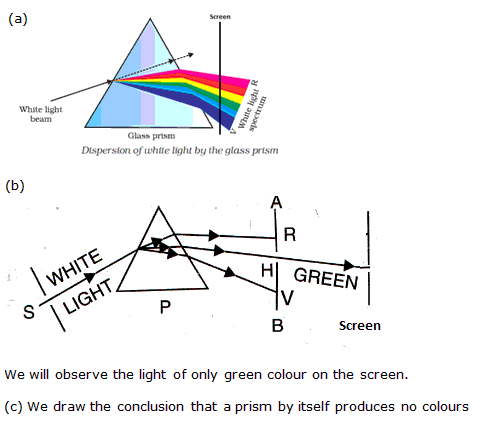
Solution 7
(i) It passes parallel with respect to the base of the prism.
(ii) The white light shall split into its constituent colours and a spectrum shall be formed.
Solution 8
![]()
PAGE NO-124:
Solution 9
The colour band obtained on a screen on passing white light through a prism is called the spectrum.
Solution 10
If a monochromatic light passes through a prism, deviation will occur and not dispersion.
Solution 11
Dispersion occurs because light of different colour bend through different angles while passing through a glass prism.
Solution 12
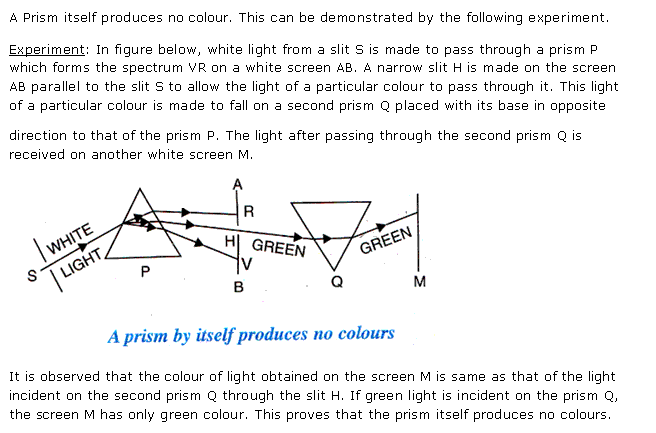
Solution 13
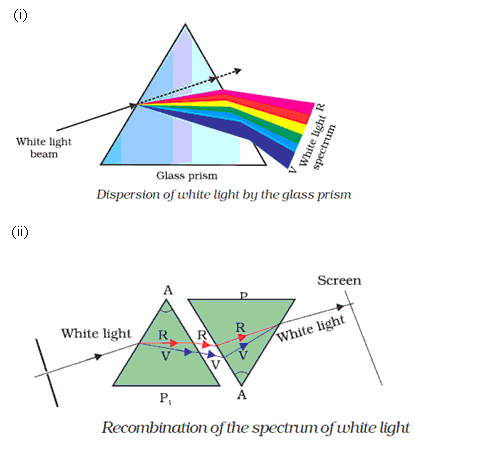
Solution 14
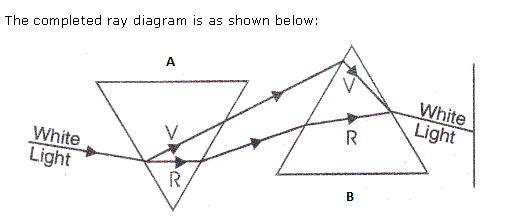
Solution 15
(i) Roentgen
(ii) Newton
(iii) Hertz
(iv) Marconi
(v) Hershell
(vi) Ritter
Solution 16
In vacuum both the colours have the same speed.In glass, red colour has a greater speed.
Solution 17
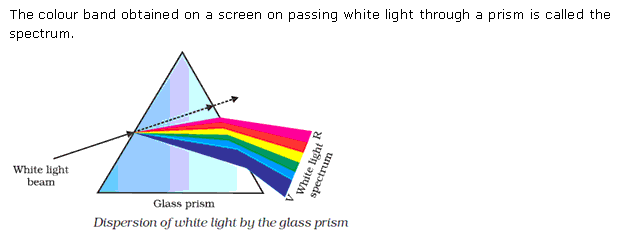
Frank ICSE Class 10 Physics Solutions Light
PAGE NO-126:
Solution 1
(a)
(v) less than one focal length
Ans1(b)
(iii) inverted and magnified.
Ans1(c)
(E) (i), (ii) and (iii)
Ans1(d)
(D) (ii) and (iii) only
Ans1(e)
(ii) real
Ans1(f)(ii)
virtual, erect, diminished
Ans1(g)
(v) Both the images are real and inverted.
PAGE NO-127:
Solution 2
(a) Principal focus: Rays of light can pass through the lens in any direction and hence there will be two principal foci on either side of the lens and they are referred to as the first principal focus and the second principal focus of a lens.First Principal Focus (F1)It is a point on the principal axis of the lens such that the rays of light starting from it (convex lens) or appearing to meet at the point (concave lens) after refraction from the two surfaces of the lens become parallel to the principal axis of the lens.Second Principal Focus (F2)It is a point on the principal axis of the lens such that the rays of light parallel to the principal axis of the lens after refraction from both the surfaces of the lens pass through this point (convex lens) or appear to be coming from this point.
(b)

Solution 3
(a)
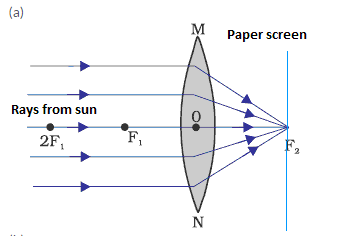
(b)
(i) Rays from sun can be regarded as parallel rays.
(ii) The point is called ‘Focus’.
(iii) A convex lens is used to focus the sun rays on a piece of paper to burn a piece of paper. A large amount of heat gets concentrated at a point and is sufficient to burn the piece of paper.
Solution 4
(a) A convex lens with short focal length can be used as a magnifying glass.
(b) A simple magnifying glass forma a virtual, erect and magnified image of a tiny object which is distinctly seen by the eye because the eye lens converges the rays to form a real image on the retina.
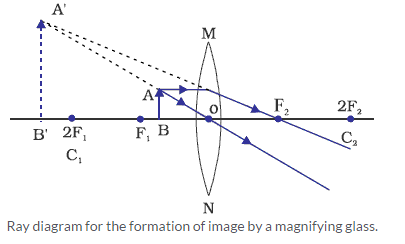
Ray diagram for the formation of image by a magnifying glass.
Solution 5
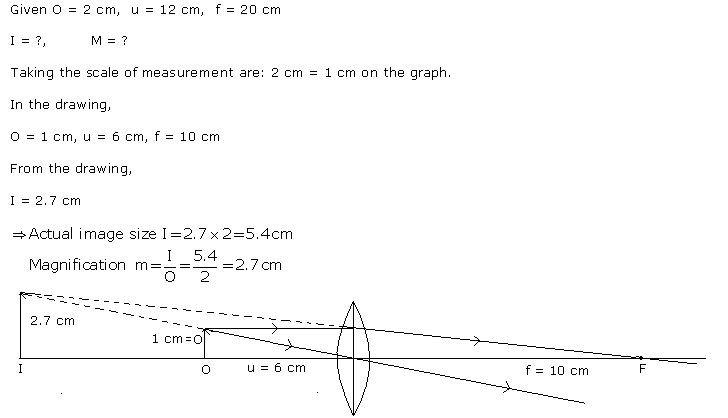
PAGE NO-128:
Solution 6
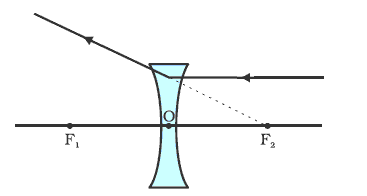
Solution 7
(a) The image of the objects at different distances from the eye is brought to focus on the retina by changing the focal length of the eye lens. This is called the power of accommodation of the eye.
(b) Accommodation is achieved with the help of ciliary muscles. To focus the distant objects, the ciliary muscles are relaxed causing the eye lens to become thin and thus increasing the focal length of the eye lens. To form the image of a near object on the retina, the ciliary muscles contract and thereby pull the ends of the choroid closer. Thus, the eye lens thickens to shorten its focal length and converges the rays to form the image.In this manner, by changing the focal length of the eye lens, the image of the objects at different distances is brought to focus on the retina.
(c) A converging lens of suitable focal length is used in the spectacles worn by an old lady for knitting.
Solution 8
Nature of image: Real, inverted and magnified.
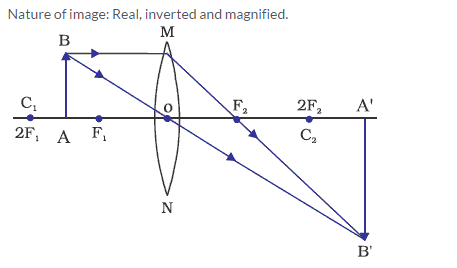
Solution 9
(a)
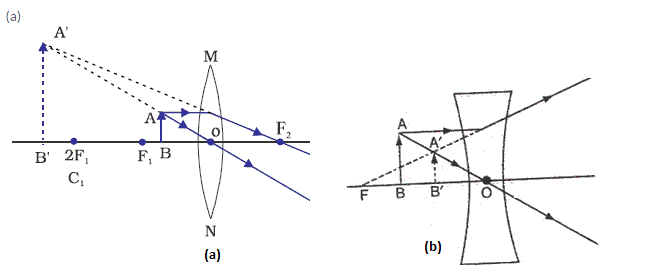
(b) In both the cases the image formed is virtual, upright and on the same side of the lens but the image formed by a convex lens is magnified and that formed by a concave lens is diminished.
Solution 10
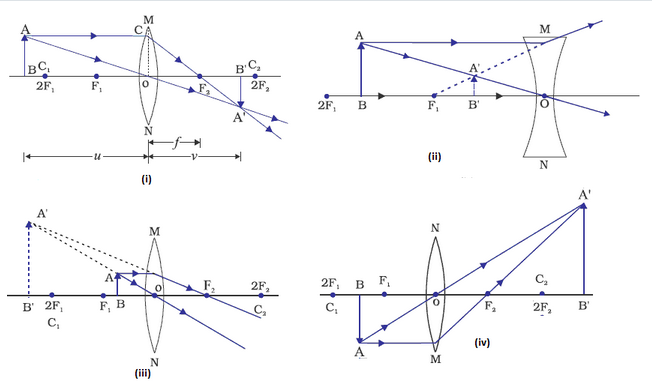
Solution 11
(a) A, B, C and D are microwaves, infrared waves, ultraviolet light and x-rays respectively.
(b) Radiations B (microwaves) have a higher frequency.
(c) Common properties of e-m spectrum:
(i) All electromagnetic waves travel with the same speed in vacuum (or air) which is equal to the speed of light i.e. 3 x 10
8
m/s.
(ii) These waves are unaffected by the electric and magnetic fields.
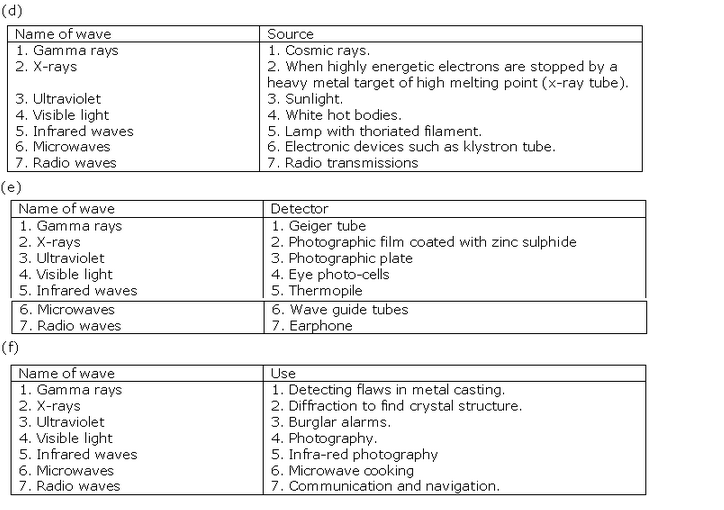
PAGE NO-129:
Solution 12
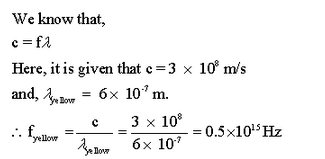
Solution 13
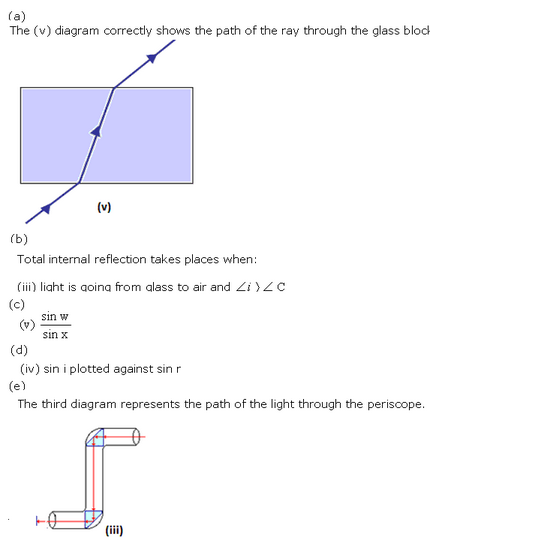
PAGE NO-130:
Solution 14
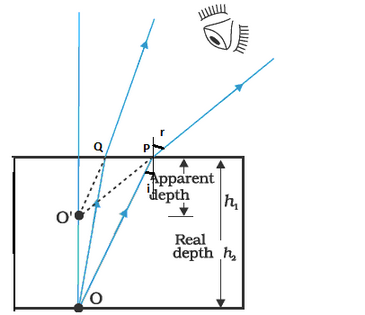
(i) Angle of incidence
(i) of ray OP is marked in the above diagram.
(ii) Angle of refraction (r) of ray OP is marked in the above diagram.
(iii) The position of image of the object (O’) as seen from above is marked in the diagram.
(iv) An approximate path of ray OQ is shown in the above diagram.
(b) Water is a denser medium as compared to air; so on passing from water (denser) to air (rarer) the speed of light of light increases and it bends away from the normal. (c)Refraction is the bending of light as it passes from a medium of one optical density into a medium of a different optical density, as from air to water or water into air. The amount of bending is dependent upon the incident angle of the light. In the diagram below, a light ray, “A” strikes the water at right angles and passes through the surface without bending. But as the incident angle decreases (becomes less than 90 degrees) the light bends more and more?rays “B” and “C.” Light striking the surface parallel to the surface, bends downward.Since light is coming into the water from all directions, refraction creates a cone of light with its base on the surface and its apex at the fish’s eye. The base of the cone is a circular opening at the surface through which the fish sees the entire outside world. This opening is called the “Fish’s Window”. Only the light passing through the window enters the fish’s eye. Notice line “D,” It’s a ray entering the water beyond the window; refraction bends it such that it cannot reach the fish’s eye.
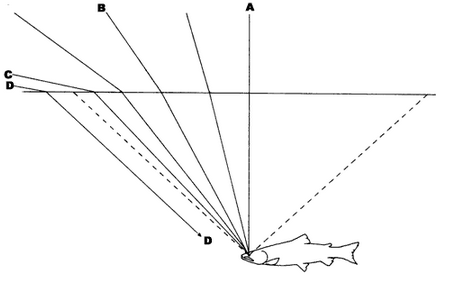
Solution 15
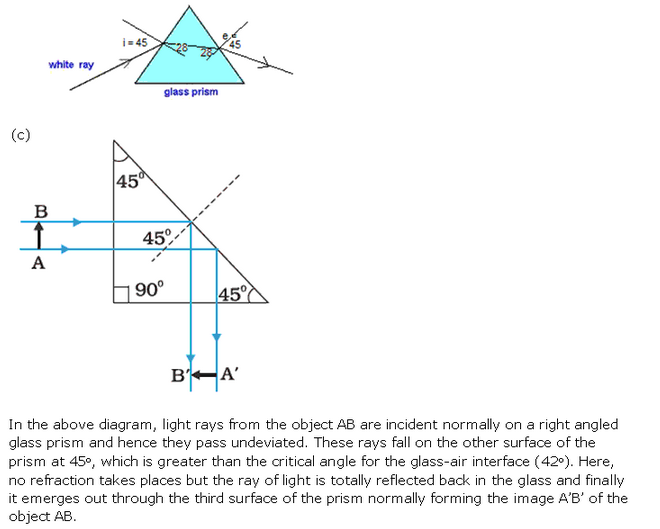
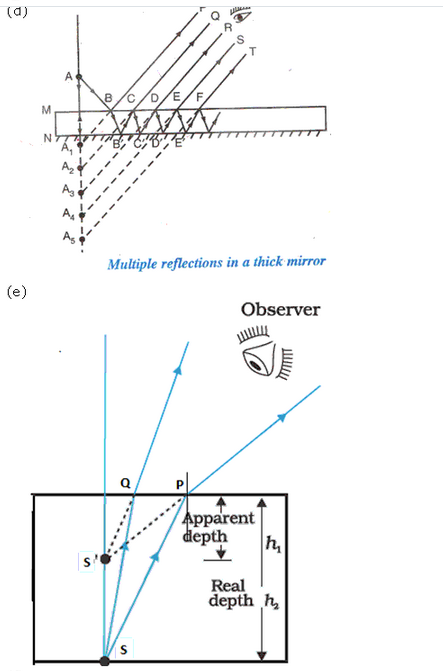
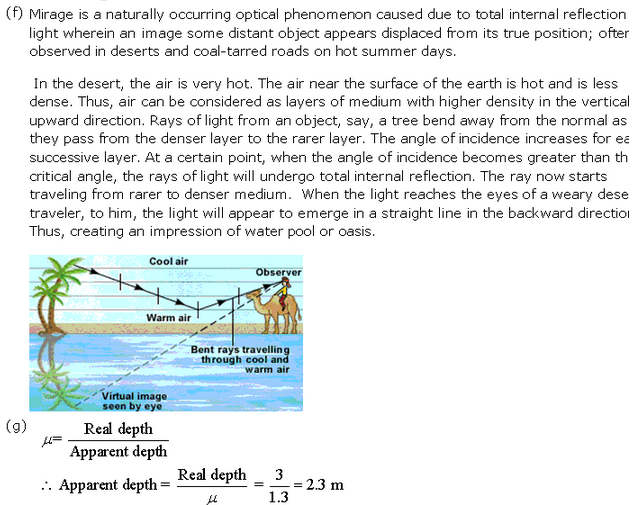
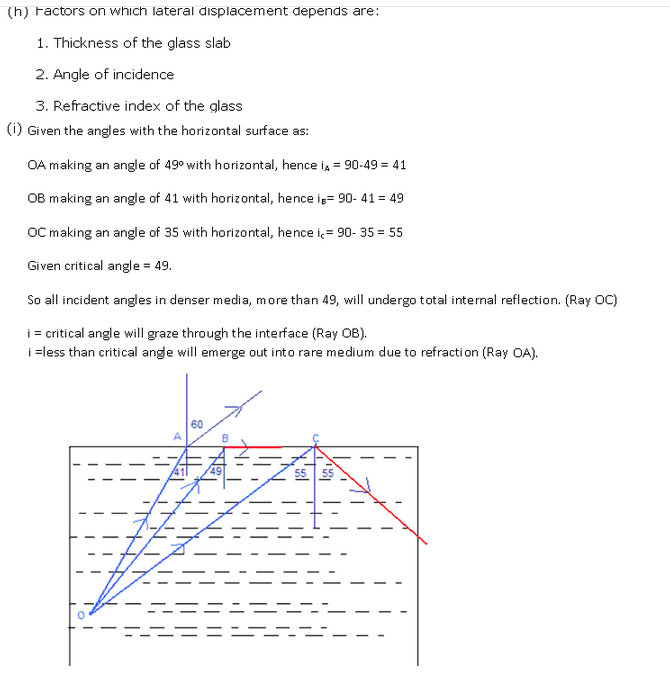
PAGE NO-131:
Solution 16
Critical angle: The angle of incidence in the denser medium for which the angle of refraction in the rarer medium is 90
o
.Total internal reflection: It is an optical phenomenon that occurs when a ray of light strikes the boundary of denser medium at an angle greater than the critical angle w.r.t. the normal of the surface; this ray is then totally reflected back into the denser medium.The two necessary conditions for total internal reflection to take place are:
1.The light ray must proceed from denser to rarer medium.
2. Angle of incidence in denser medium should be greater than the critical angle for the pair of media in contact.
Solution 17
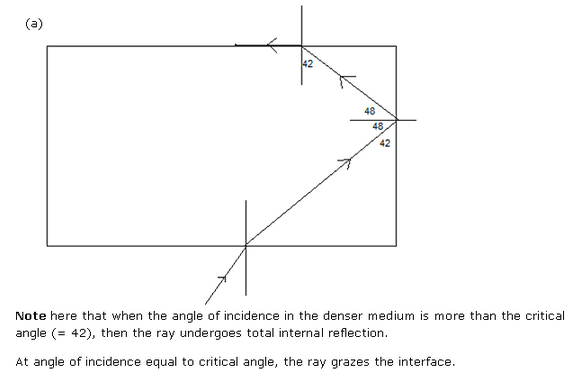
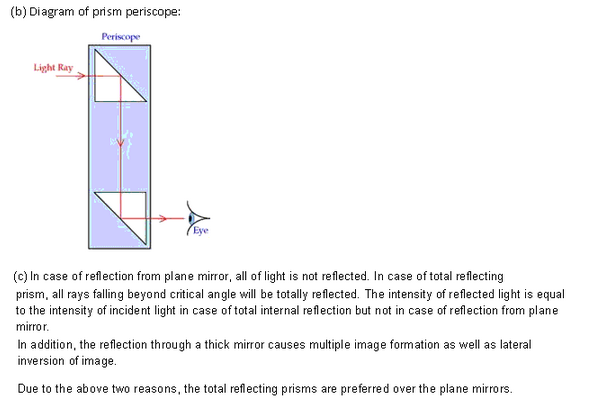
Solution 18
(a) Dispersion
(b) Red colour at X and violet colour at Y.
(c) Above X, we would detect infra-red radiation and below Y, ultra-violet radiation.
PAGE NO-132:
Solution 19
Two properties of ultraviolet radiation different from the visible light:1. Ultraviolet radiation can pass through quartz, but they are absorbed by glass.2. They are usually scattered by the dust particles present in the atmosphere.
Solution 20
Three properties of infrared radiations similar to the visible light:
1. They travel in straight lines as light does, with a speed equal to 3 x 10
8
m/s in vacuum.
2. They obey laws of reflection and refraction.
3. They are unaffected by electric and magnetic fields.
Two properties of infrared radiation different from the visible light:
1. They are absorbed by glass, but they are not absorbed by rock-salt.
2. They are detected by their heating property using a thermopile or a blackened bulb thermometer.
Solution 21
Waves A are Gamma radiations.Waves B are infrared radiations.In vacuum, both travel with the same speed. Hence, the ratio of their speeds is 1:1.
PAGE NO-133:
Solution 24
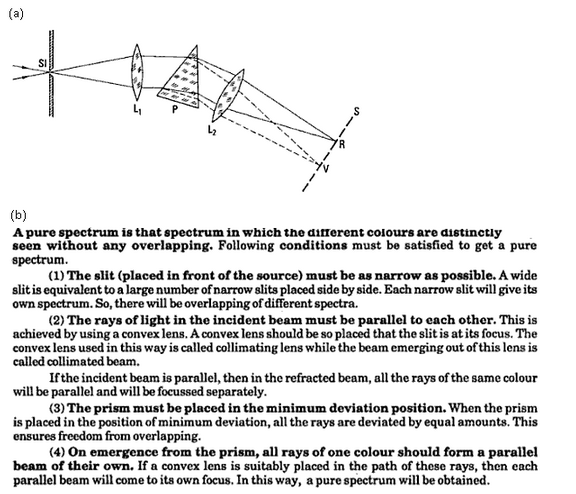
Solution 25
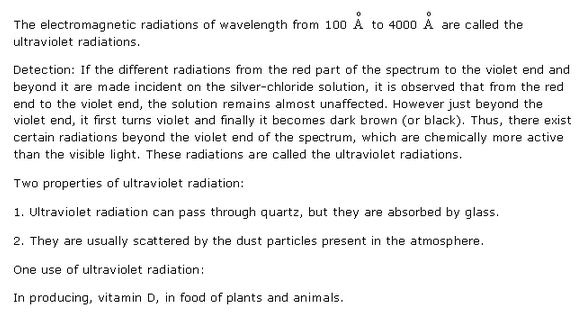
Solution 26
Three properties of ultraviolet radiations similar to the visible light:
1. They travel in straight lines as light does, with a speed equal to 3 x 108 m/s in vacuum.
2. They obey laws of reflection and refraction.
3. They are unaffected by electric and magnetic fields.
Solution 27
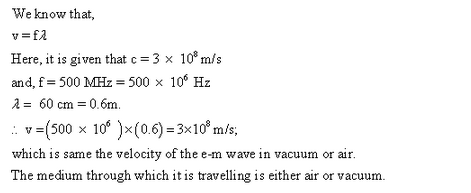
Physics Chemistry Biology Maths
RD Sharma Class 10 Solutions
Video Solutions